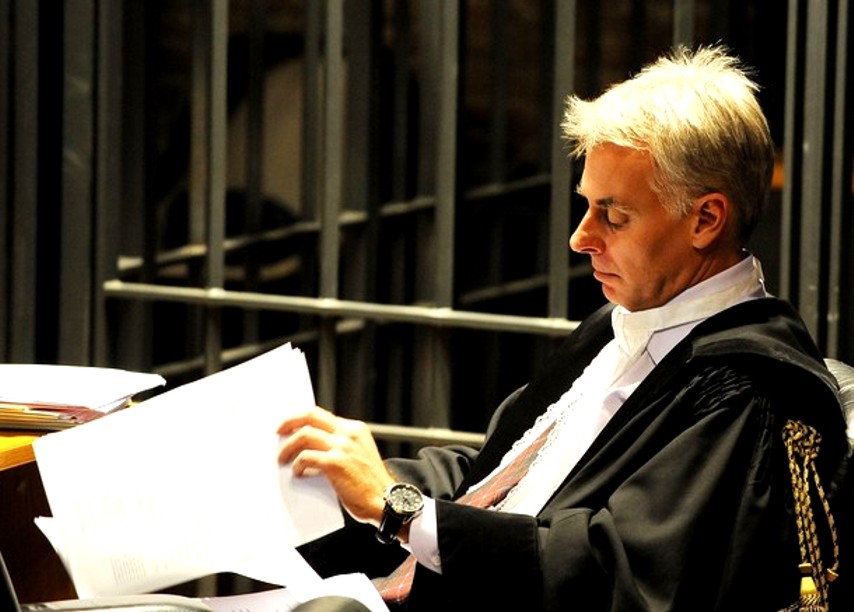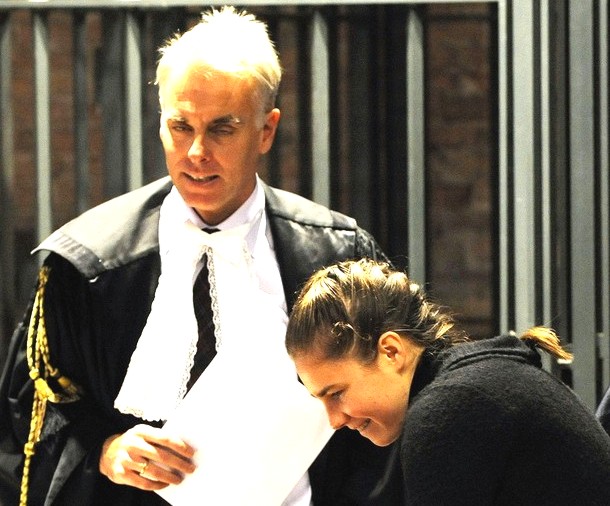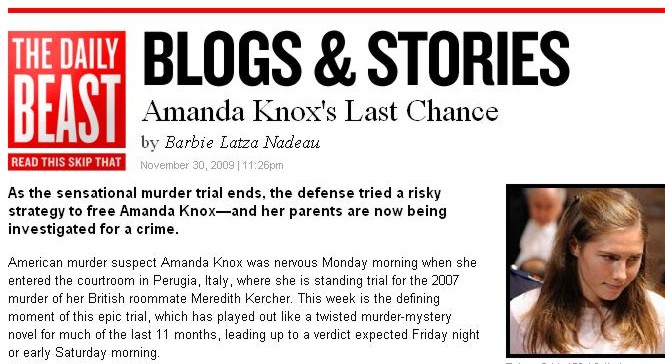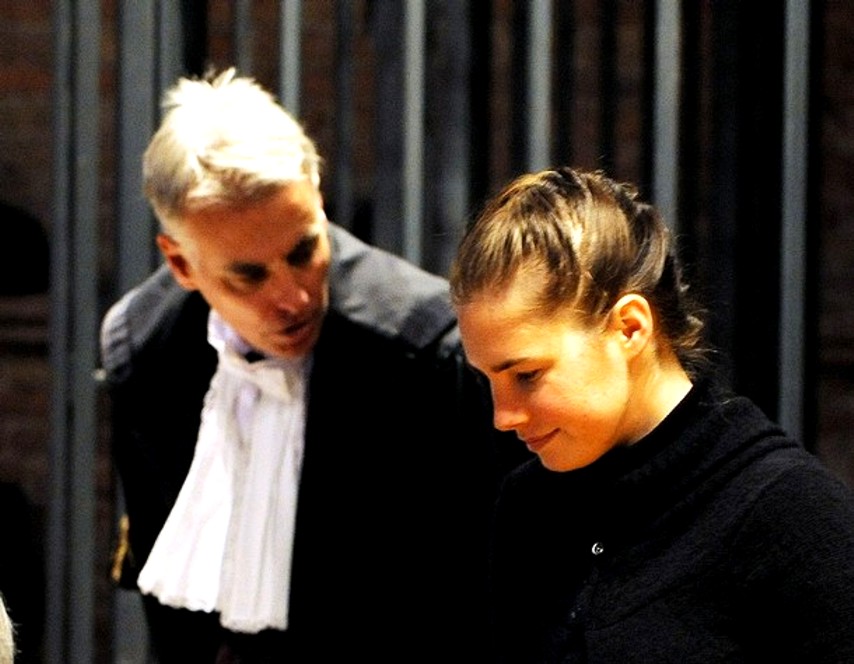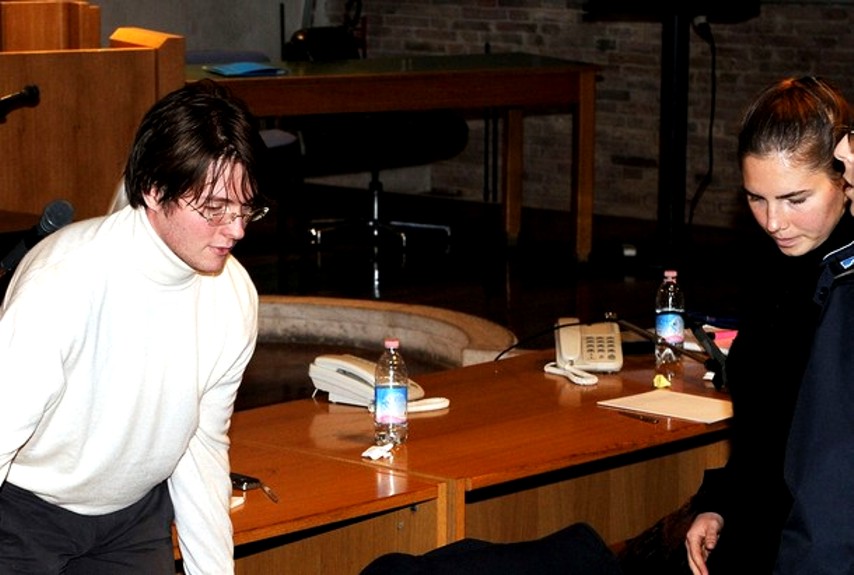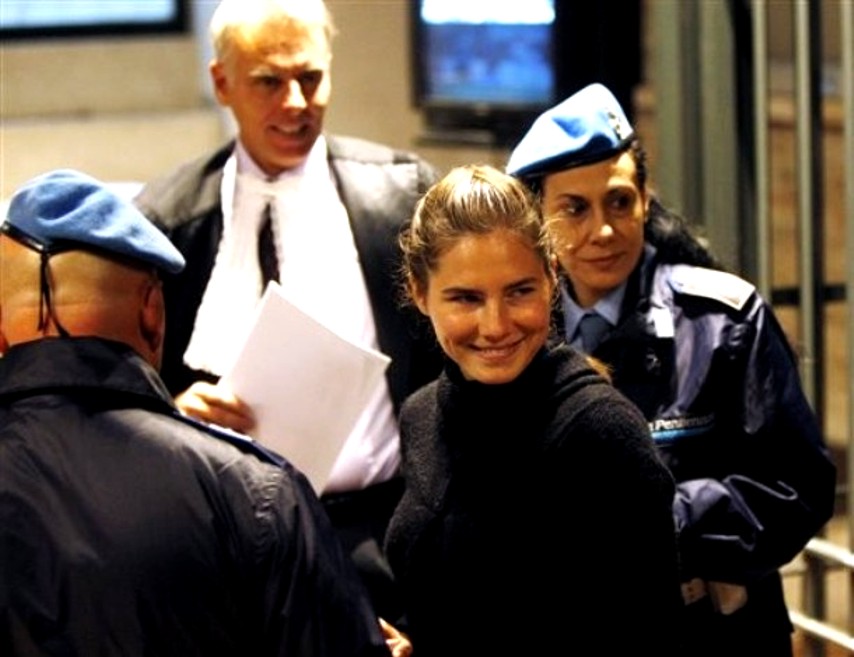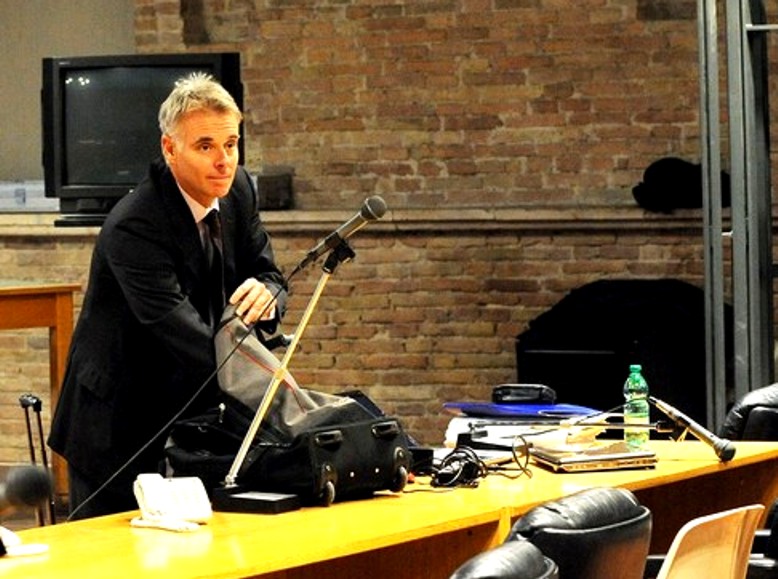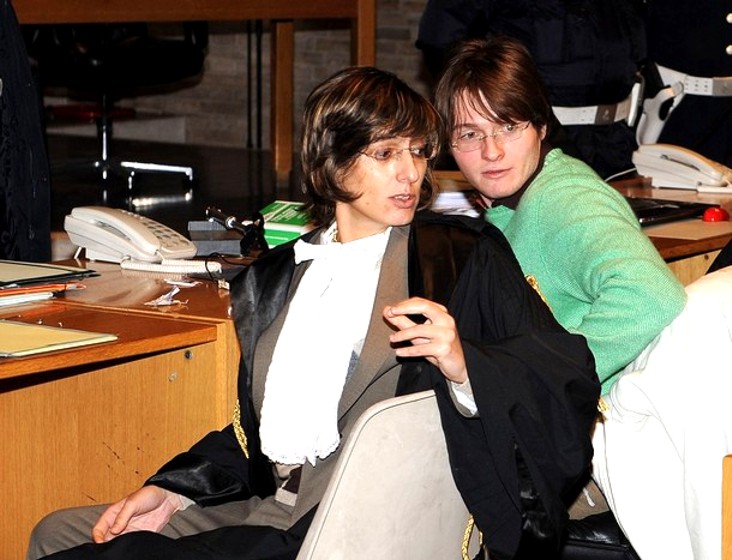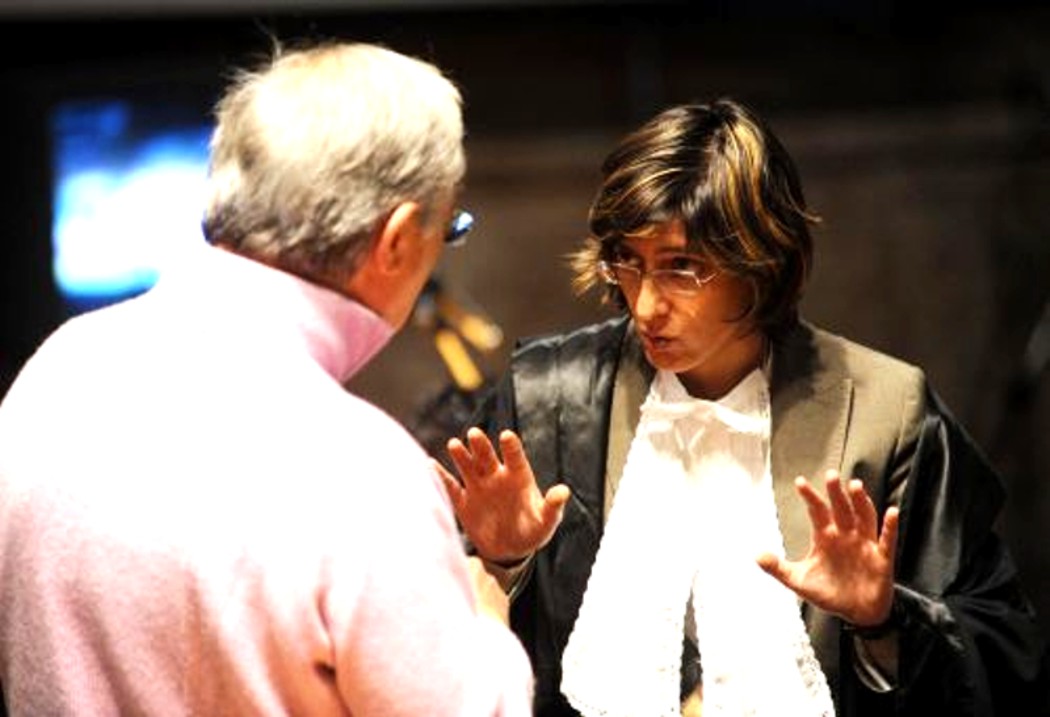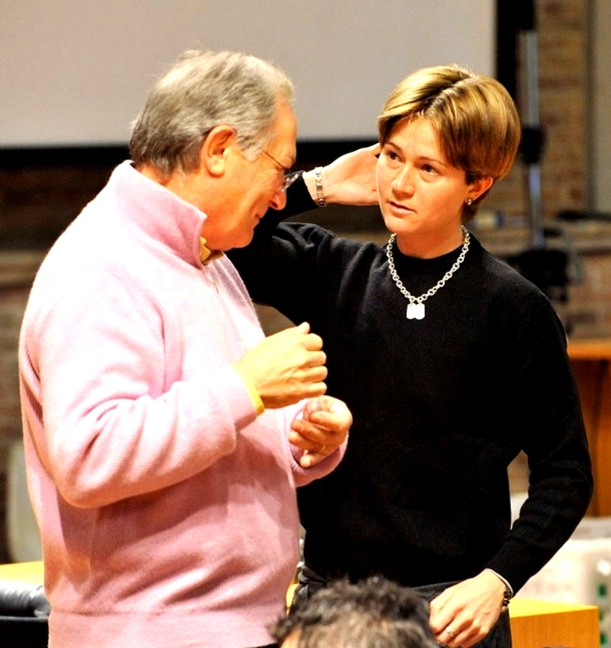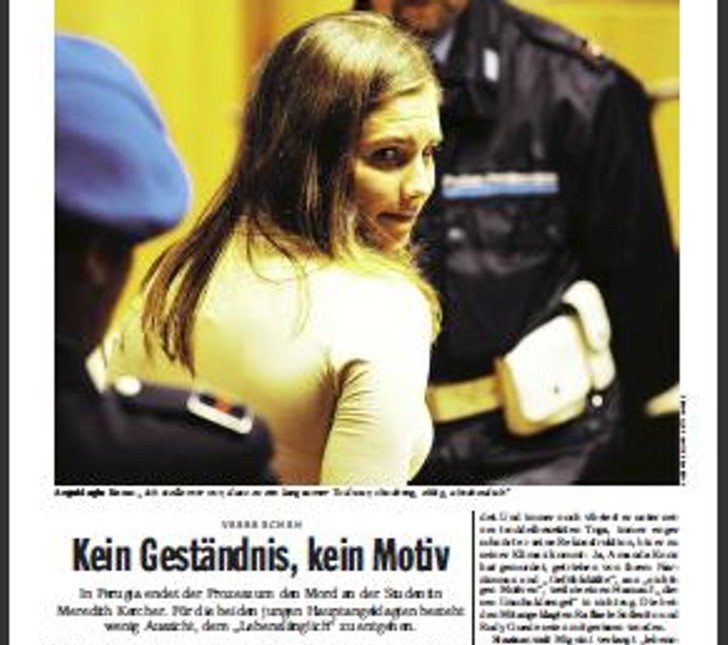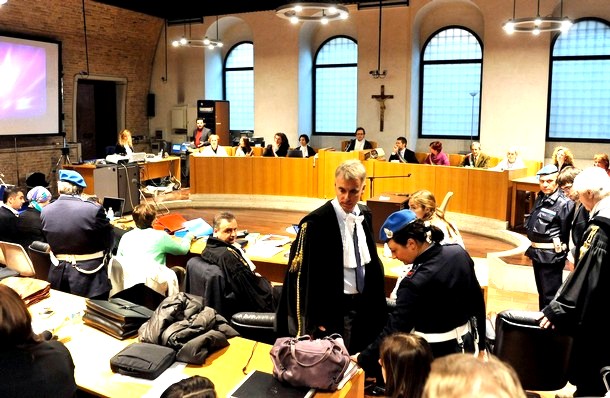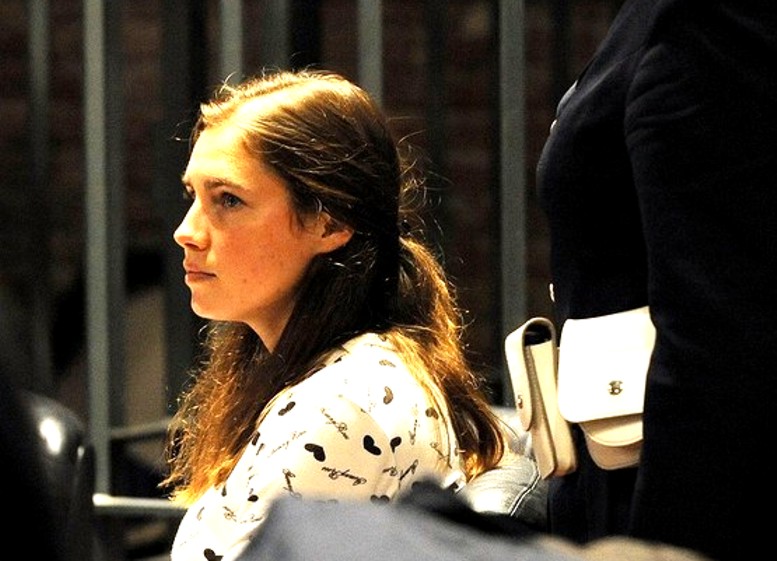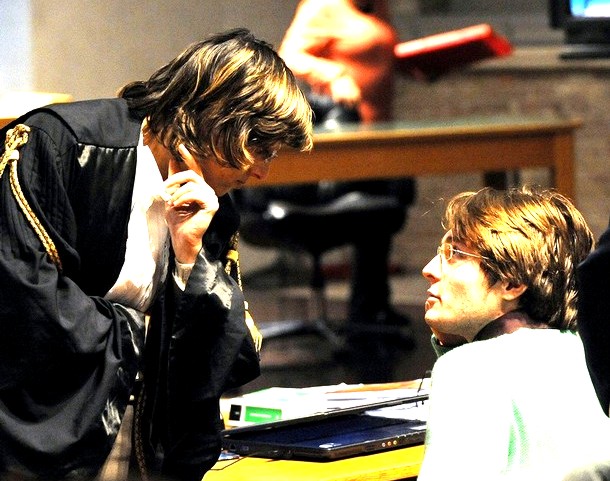
Wednesday, December 02, 2009
The Summations: La Nazione On Arguments Of Knox Lawyer Della Vedova
Posted by Tiziano
Final report on Mr Della Vedova yesterday while we wait for the first reporting on Mr Ghirga today. This is from the report of Il Tempo translated.
By Marino Collacciani
Knox comes into court. Beautiful, very beautiful, with a magnetic gaze. And what if she were Eva Kant instead of Amélie from Seattle? No, the magnificent companion of Diablik is probably in some secret hideout in Clermont, and Amanda Knox today appears further and further away from the clutches of Inspector Ginko. And then Raffaele Sollecito doesn’t look like Diabolik at all…
There is certainly a great distance between the life imprisonment of the prosecutors and and the complete liberty demanded by the defence. The Giussani sisters, creators of the cult crime comic, would have certainly drawn and dramatised a better trial, with proof in hand. Because it really isn’t absolutely simple to take the side of either the “innocentisti” or the “colpevolisti”: those two, Raffaele and Amanda, could be our children, brothers or sisters. The problem is that Meredith Kercher could be too… And so therefore what? The best thing for now is to prepare the crime news. And to look forward to the third and final stage of the Perugia trial.
Today, indeed, another defender of the American girl will take the stand, then the rejoinders which will continue tomorrrow: then the arrival of Friday, when the judges could go into deliberations and hand down the verdict. Which will certainly be appealed. So, two families, two states of mind. Knox’s, all present in court, optimistic about the the judgement expected for the first time. Amanda’s father, Curt Knox, spoke of “another step in the right direction”. Then he explained how Amanda was: “She bearing up quite well. Today was good for her (yesterday, ed), hearing the truth instead of fantasy.” But the members of the Kercher family stay silent, for they have put their trust completely in lawyer Maresca. However, they will be there on Friday in court to listen to the judgement.
The address of Dalla Vedova started with a 360 degree turn around from an assumption: that is, the involvement of Amanda Knox, a “wholesome student overtaken by a tsunami”, was all the outcome “of a mistake”. Because the initial statements made to the police by a girl “in difficulty and totally confused” which linked her herself to the house of the crime and Patrick Lumumba (who turned out to be comletely extraneous to the event and thus exonerated) “had to be checked”. And Amanda had to be freed as he was. In court in black jumper and pants, her hair pulled back in a plait, Amanda confided, in a note left on the desk and written in English, the fear of “losing myself, of being condemned for something I have not done”.
The lawyer spoke then of “absolute lack of motive” or, rather of the “illogicality” of the theory of the prosecution about a crime linked to a vendetta or a sexual assault. But also of the “unlikelihood” of the kitchen knife seized from the residence of Raffaele Sollecito, with the DNA of Knox and Kercher on the blade, indicated by the prosecution as the weapon of the crime. “Why take it to the house in Via della Pergola - he asked - when there were so many there?” And finally for Della Vedova the group violence “is not proved”, just by virtue of “lack of space” available for the attackers (Knox, Sollecito and Guede, according to the PM) in Meredith’s bedroom where traces of Knox are “equal to zero, because she was not there”.
The Summations: Andrea Vogt Summarises Knox Defense By Della Vedova
Posted by Peter Quennell
Andrea Vogt has a report in the Seattle PI that adds significant detail to that of ABC’s Ann Wise below. Key excerpts.
“Amanda Knox never should have been arrested. And everything that has happened since then has been part of an attempt to maintain an accusation, that, bit by bit, has disintegrated.”
It began with “psychosomatic” observations of one powerful cop, he said, Edgardo Giobbi, the former director of the violent crimes division of the central operations unit in Rome, who on “investigator’s instincts” suspected Knox from the beginning.
“Immediately after the crime, they focused attention on her,” said Dalla Vedova. “They started recording her conversations. They were quick to say ‘case closed,’ but it was a mistake the police made in the beginning, then they couldn’t let it go.”
He played tapes of secretly recorded conversations between Knox and her other roommate in the days after the slaying. They comforted each other in broken Italian and English….
Like his colleague Giulia Bongiorno the day before, Dalla Vedova spent considerable time countering attacks on Knox’s character, reading letters from the owner of a Seattle art gallery where she worked and citing former teachers. He described her as a “regular girl leading an ordinary, serene life with positive values.”
“I’ve known her for two years. She is ‘soap and water’” he said, using the Italian phrase to describe someone as wholesome. Knox, in a conservative black turtleneck sweater and with her hair pulled back from her face in a neatly woven French braid, appeared concentrated on her lawyer’s every word.
Knox is also expected to make a statement to jurors, at whom she nods and makes eye contact with each time she enters or exits the courtroom. On Thursday, the prosecution and the Kercher family attorney will be allowed to give rebuttal remarks before the case goes to the jury for deliberations.
Francesco Maresca, the attorney representing the Kercher family, said the attorneys intend to remind the jury of the “ample and massive” amount of forensic and circumstantial evidence behind the prosecution’s case. But the defense has one more day to sow more seeds of doubt.
Tuesday, December 01, 2009
Barbie Nadeau Cracks The Mystery Of Why Sollecito’s Lawyer Was Arguing For Knox
Posted by Peter Quennell
Click above for the report in the Daily Beast.
Yesterday’s strategy by Ms Bongiorno had been puzzling us behind the scenes. Even the Italian media seemed confused. Some thought she was subtly saying that Knox had framed Sollecito. This analysis sounds authentic.
American murder suspect Amanda Knox was nervous Monday morning when she entered the courtroom in Perugia…
Sollecito’s co-counsel Giulia Bongiorno…. surprised court observers and spent most of the morning ignoring her own client. Instead, she defended Knox even though Sollecito is the only of the two with DNA evidence in the room where Kercher was murdered…
By doing the work of Knox’s defense team, Sollecito’s own defense took a calculated risk that it will be harder for the jury to convict them both. But in doing so, she paved the way for the two to be judged as one, meaning they will either both be acquitted or both receive life sentences.And by defending Knox and attacking the forensic evidence against her…. [Bongiorno] is banking that Knox’s lawyers will also do their bit to defend Sollecito later this week when it is their turn.
“She is not Amanda the Ripper,” Bongiorno told the jury, which at times must have been wondering when she would get to Sollecito. “She is a little crazy, extravagant. She does the cartwheels in the police station because reality for her is too strong to deal with. She is spontaneous, immediate, and imprudent.”
It was a moment of obvious relief for Knox. The last few weeks have been particularly arduous for her. Two weeks ago, Rudy Guede, the man who has already been convicted for his part in Kercher’s murder, testified in his appeals trial that he saw her silhouette in the window of the crime scene the night of the murder.
The same week, the prosecutor painted a disturbing picture of Knox as a drug-fueled vixen who called Meredith Kercher “prissy” before threatening her at knifepoint to have group sex with Guede and Sollecito. Then last week as the civil plaintiff’s closing arguments against her concluded, Knox was called a “dirty minded she-devil” by lawyers for Patrick Lumumba….
[Monday] was the best day the defense has had in this trial. Bongiorno’s oratory was a tribute to criminal defense. The jury didn’t take their eyes off her as she weaved a story separated by her own self-titled chapters. And when Knox’s defense lawyers begin their summation, they are expected to do their part and pick up where Sollecito’s defense left off.
“We are really four lawyers with two clients,” Knox attorney Carlo Dalla Vedova said after court. “We are all in the same boat.” Soon the jury will decide whether it will stay afloat.
The Summations: Today’s Arguments For Amanda Knox By Her Lawyer Della Vedova
Posted by Peter Quennell
Ann Wise reports today’s arguments for Knox on the ABC news-site. Key excerpts:
Amanda Knox’s lawyer told the jury today that Italian prosecutors abruptly switched the alleged motive for what they charge was Knox’s murderous assault on her British roommate Meredith Kercher.
“The motive is fundamental,” attorney Carlo Dalla Vedova told the jury in Perugia, Italy, where Knox has been jailed for the last two years. “But today the motive has been changed at the last minute.”...
“At the very end of the trial the prosecution has changed the motive, not in the course of the trial and supporting it with evidence,” Dalla Vedova said. “It is no longer the result of a sex party gone wrong. Now it is Amanda who organized the crime out of vengeance.”..
“Amanda stayed in Perugia, she did not run away. She did not go to Germany when her aunt told her to come. On the morning of the 5th, the day she was interrogated, she went to school. She wanted to be in Perugia,” Dalla Vedova told the jury. Knox, he said, was a “clean-faced young girl. I know her well. And she was swept away by a tsunami” of events.
He described the police investigation as an “incredible evolution of facts that led to the arrest of Amanda Knox. It was a sort of rush.” The lawyer said police looked at Knox as a suspect because she behaved oddly in the days after the murder, including doing a cartwheel in a police station while waiting to be questioned, behavior he explained by saying she as “a girl who was alone on the other side of the world from her family.”...
Dalla Vedova challenged some of the evidence presented by prosecutors, particularly the claim that a knife found in the kitchen of Knox’s co-defendant and former boyfriend Raffaele Sollecito had a speck of Kercher’s DNA on the blade and Knox’s DNA on the handle. Prosecutors claim the knife is the murder weapon….
Knox, he said, “has been the object of a trial through the media, of slander, of violation of privacy… You have to keep in mind the great influence of the press on this trial.”
In the courtroom, Dalla Vedova also lashed out the prosecution’s demand that Knox be sentenced to life in prison. “Remember,” Dalla Vedova said, “that life in prison is the most severe punishment in our country. There is nothing worse than what the prosecutor has asked for Amanda.”
Ann Wise also adds that the jury could get the case as early as this Thursday - two days earlier than we have heard previously.
The Summations: Sollecito’s Defense As His Home Town Media Outlet Described It
Posted by Tiziano
Giovinazzo Live is a media outlet in Raffael Sollecito’s home town just to the north of Bari in the south-east of Italy.
Below here is a translation of their report on Ms Bongiorno’s remarks yesterday. Ms Bongiorno, Raffael Sollecito, his father, and his sister are seen in the images above and below.
A Probing Address by Raffaele Sollecito’s lawyer
By Gianluca Battista
There was a bit of everything in the defence address by Giulia Bongiorno, well-known criminologist, part of the defence team for Raffaele Sollecito, from Calmandrei to Socrates, and passing by Sergio Endrigo.
Yesterday before the court of the Assizes in Perugia, one of the most noted female lawyers in Italy took the stand in the first-stage trial which sees her client and Amanda Knox accused of the murder of the English student, Meredith Kercher.
“In this trial Raffaele Sollecito seems to be a silent “little attachment” of Amanda and one doesn’t really understand what use he is,” Bongiorno attacked. “In this trial nothing is made known about him. His motive is not known. Amanda is seen as the witch (sorceress), but Raffaele?”
“According to the lawyer for the information sciences engineer from Giovinazzo, who also quoted a song by Sergio Endrigo, the prosecution reconstruction is devoid of elements which are essential to support it.”
For the Sicilian lawyer, “(It is) a murder trial without a motive, a trial which leaves one stupefied.“The lawyer recalls that on the morning of November 2nd it was Rafaele Sollecito himself who alerted the Carabinieri.“It’s a surprising idea - Bongiorno said - that an assassin should call the Carabinieri and say: come and get me, I’m at the crime scene. Raffaele called the Carabinieri and together with Amanda awaited their arrival sitting on the steps in front of the crime house.”
Then there were many references to the other co-accused of the crime, Amanda, depicted by many as a perverse spirit. But for Bongiorno “Amanda Knox is the “Amelie from Seattle, she looks at people with the eyes of a little girl, fizzing with energy and has a spontaneous and rash attitude to life.”
The defender of the young man from Giovinazzo thus recalled the protagonist of the film “The Fabulous World of Amelie” with whom her friends compared the American girl. The same video which Knox and Sollecito claimed to have seen in the hours while Meredith Kercher was being killed.
Then an important reference to the statements made by Knox during the questioning at police headquarters, the same which led to the arrest of the innocent Patrick Lumumba. “Amanda was denied the right of staying silent,” she stressed.
Bongiorno then recalled that Knox, at the time barely twenty, had just arrived in Italy, did not speak Italian and did not know the laws.“Does it seem so strange - she asked, referring to the police interrogations - that she fell into despair, put into statements things which were not true and then did not have the courage to change them? You must decode Amanda.”
The lawyer then said that Knox has been described as a female “Jack the Ripper”. “But to me - she commented - it is difficult to think of her in this way. I see her in the way Amanda’s friends do, that is, she looks at the world through Amelie’s eyes.”
As for the marking of Meredith’s bra with the prints of Raffaele, collected 46 days later by the investigators, Bongiorno has no doubts: “It should have been discarded from the outset,” she thundered.“Either the prosecution explains how it was moved - she added - or you must have the courage to consign it to the rubbish bin. A just verdict could be contaminated by a fastener collected in this way.”
Germany’s Der Spiegel Posts An Analysis Of The Case
Posted by Peter Quennell
Please click above for Der Spiegel’s analysis in German
The case is being followed closely in Germany. Many Germans take vacations in Italy and they know the country well, and of course Rudy Guede was arrested there. Reporting is good, and TJMK see a number of hits daily from Germany.
With thanks to Has-Georg for the heads-up..
Andrea Vogt Asks Some Useful Questions Concerning The Legal Process
Posted by Peter Quennell
Click here to read all of this well-researched report on the Seattle P-I website.
After presenting an overview of the system similar to those posted here by Nicki and Commisario Montalbano Andrea Vogt asks two experts on the system these questions.
Do jurors have to find Knox guilty beyond a reasonable doubt?
Yes. The concept of proof beyond a reasonable doubt has long been a part of Italy’s justice system. It was formalized and passed into law in 2006.
Knox’s defense lawyer Luciano Ghirga said his team will remind jurors that, even after more than 40 hearings, everything is still in doubt.
The court’s ruling (which is not called a verdict in Italy) is made by an eight-member jury: six laymen and two professional judges. They will vote, and the majority rules. In the case of a 4-4 tie, acquittal overrules.
Could Amanda Knox have plea bargained?
Knox maintains her innocence.
However, while not completely analogous to plea bargaining, Italy does have a similar alternative to trial, also a part of the 1988 reforms. The alternative is not applicable for serious crimes, such as murder, punishable by more than five years in prison.
Suspects who cooperate fully with the police, however, may become eligible for a bundle of mitigating circumstances that would lower prison sentences. A judge may also choose to apply aggravating circumstances to increase a sentence.
Negotiation on the evidence—in which both sides agree what can be admitted—is also available when defendants choose a fast-track trial, as did Rudy Guede, sentenced to 30 years last year for his role in the case for which Knox is on trial. Guede is appealing his conviction.
Why does the figure of prosecutor seem so powerful in Italy?
The prosecutor is a powerful figure in Italy connected to the judiciary, not elected or appointed. While there is a career separation between judges and prosecutors, the qualifying examination and training are common, That has made judges and prosecutors close both culturally and professionally.
In the U.S., prosecutors are appointed in federal system and typically elected in the state system, hence it is common to hear cases referred to as The State vs. X.
In Italy, protections were put in place precisely to prevent the state from pursuing or persecuting, hence the independence of prosecutors.
As a result, prosecutors haven’t shied away from taking on politicians. Italian Premier Silvio Berlusconi, for example, faces a series of criminal procedures in the courts.
That independence , some argue, is precisely the protection needed as a check against government power, and without it, corruption could not be exposed, said Maffei. But others argue that prosecutors wage their own political battles. using their independence to attack political opponents.
Another major difference: the prosecutor supervises the investigation rather than letting police handle it.
Further, he or she also has no discretion over the decision to seek charges. There is a constitutional principle of mandatory prosecution. If there is sufficient evidence to build a case against a defendant, a prosecutor must seek an indictment.
In the U.S. prosecutors can and do drop cases for such reasons as workload or because the defendant has agreed to help with a criminal investigation.
Was it legal for Knox not to have an attorney present when police questioned her?
Yes and No.
Amanda Knox’s interrogation falls into a gray area of the law because she came voluntarily to the police station and was being interviewed in the beginning as someone who could become be a witness, not a suspect.
Then, in the course of questioning by police in November 2007, she blamed Patrick Lumumba for the slaying, and said she was present at the scene of the crime. Lumumba was innocent. Knox has since denied she knows anything about the slaying and says she wasn’t in the flat the night Kercher was killed. Limumba is suing Knox for slander.
The law is very clear: A suspect must not be interrogated without a lawyer.
Once a suspect, an interrogation must be interrupted, the suspect read his or her rights to remain silent and be provided a lawyer. Italian law does not allow waiver of one’s right to counsel. Even if a suspect doesn’t want a lawyer, the authorities are required to appoint one.
If a suspect’s freedom of movement is hindered, the interrogation must be videotaped.
In Knox’s case, a video or audio recording of the entire police interrogation (authorities have denied that any such recordings exist) could identify when police began treating Knox as a suspect and what procedures were followed.
In fact, Italy’s Supreme Court has already said that some of her early statements may not be used against her because they were made without an attorney present.
Monday, November 30, 2009
The Summations: Nick Pisa Sums Up Sollecito Lawyer’s Remarks About Knox DRAFT
Posted by Peter Quennell
The Summations: Sollecito’s Lawyer Says Knox Was Not The Sort To Commit Murder
Posted by Peter Quennell
TGCom’s headline that Sollecitos lawyer claimed Knox was framing Sollecito is not born out by this longer report from Richard Own in The Times.
A lawyer for the defence today told the judge and jury Ms Knox was not “Amanda the Ripper” but more like Amelie, the wide-eyed innocent played by Audrey Tautou in Jean-Pierre Jeunet’s 2001 hit film of the same name.
Giulia Bongiorno, defending Mr Sollecito, said “Throughout this trial I have heard Amanda described as someone who nursed a hatred, someone who was a maneater and someone who was a diabolical witch. But she is not Amanda the Ripper. She is a fragile and weak girl.”
She said Ms Knox, 22, was like “a little girl who looks at people and the world with child-like eyes, full of energy, spontaneous and imprudent ... If anything, she is similar to the character Amelie, the French girl in the film of the same name she was watching with Raffaele the night of the murder.”
Ms Knox and Mr Sollecito claim they spent the night of the murder at his flat, smoking cannabis. However Mr Sollecito has testified that he cannot remember if Ms Knox was with him all the time….
Ms Bongiorno, an incisive front-rank Italian lawyer, said that Mr Sollecito, 25, an information technology student, could not have taken part in the murder and sexual assault of Ms Kercher since it was he who had “raised the alarm and waited for the investigators on the doorstep of the house of the crime. Would a killer do that?’‘...
In an impassioned address Ms Bongiorno said that Mr Sollecito barely knew Ms Kercher, and did not know Guede at all. The prosecution had “failed to establish any link” between Mr Sollecito and Guede. “In this trial there are many doubts, but one certainty, that the two did not know each other at the time of the crime,’’ she said. “The only link between them is the charge sheet.’’ The prosecution reconstruction of the crime was “incomplete, with the essential part missing”.
Ms Bongiorno, who successfully defended Giulio Andreotti, the former Italian Prime Minister, against charges that he was linked to the Mafia, said a bloody footprint at the cottage was not Mr Sollecito’s, as the prosecution had claimed, but came from a shoe belonging to Guede.
She used quotations from Socrates to the late Italian singer-songwriter Sergio Endrigo to support her case that the prosecution had failed to prove Mr Sollecito’s guilt “beyond reasonable doubt”. She said that the prosecution had also failed to establish a motive for the crime….
On Saturday Mr Sollecito told the court that Ms Knox was “not manipulative or violent or diabolical, as she is made out to be. She does not have a dark side, she is a girl like many others”. Luca Maori, another lawyer defending Mr Sollecito, said that Guede’s DNA was “on Meredith’s sweatshirt, it’s on her handbag, it’s on her bra. Only one person carried out this crime and it was Guede.”
He said that the bespectacled Mr Sollecito, who comes from a well to do family at Bari in southern Italy, was “a calm, quiet and reserved young man” who when he met Ms Knox in Perugia as a 23-year-old student had had “little sexual experience”.
The Summations: Sollecito’s Lawyer Ms Bongiorno Makes It To Court To Sum Up
Posted by Tiziano
This report is translated from Corriere. It predates the report warned of just below on the claimed framing of Sollecito.
Back after an ailment linked to an inflamed appendix, Bongiorno has completely recovered….
Sollecito’s lawyer is claiming the possibility of the contamination of the DNA traces…. Also that the prosecutorial reconstruction “has the flavour of an unfinished opera with the essential part missing”.
The lawyer also stressed that the proof of an acquaintance between the young man and Rudy Guede is lacking. Bongiorno said, “It is certain that the two did not know each other at the moment of the crime. The only element linking them is the prosecutor’s charge.”
Referring to what she claims is the incompleteness of the prosecutor’s reconstruction, the lawyer quoted a verse from one of Sergio Endrico’s songs: “it was a such a pretty little house but it had no roof and no kitchen”.Bongiorno said, “Sollecito was close to graduating and was nurturing his own dreams when he stumbled over a footprint which tore them away from him.” Then she spoke about the bloody footprint from a shoe, found next to Kercher’s body and initially attributed to Sollecito, but then revealed as belonging to Guede. “Raffaele - his defence lawyer underlined - was fitted into the scene of the crime by that footprint and he went to prison because of that footprint.”
Bongiorno then went on to speak of the morning when [Meredith’s] body was found, November 2nd, 2007. “Sollecito gave the alarm and waited for the investigators on the step in front of the crime house. Does it seem credible to you that a murderer would do this?” she said.

